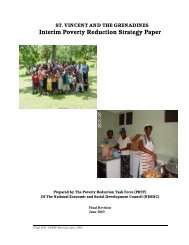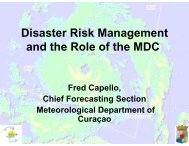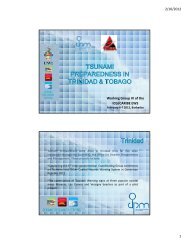The Anatomy of A Silent Crisis The Anatomy of A Silent Crisis
The Anatomy of A Silent Crisis The Anatomy of A Silent Crisis
The Anatomy of A Silent Crisis The Anatomy of A Silent Crisis
- TAGS
- anatomy
- www.bb.undp.org
Create successful ePaper yourself
Turn your PDF publications into a flip-book with our unique Google optimized e-Paper software.
Case Study<br />
56 Forum 2009: Climate Change – <strong>The</strong> <strong>Anatomy</strong> <strong>of</strong> a <strong>Silent</strong> <strong>Crisis</strong><br />
Climate change in the dry land belt —<br />
An ecological time bomb for human<br />
security in the Middle East<br />
<strong>The</strong> dry land belt encompasses 41 percent <strong>of</strong> the world’s landmass including the Sahara, the<br />
Middle East and Central Asia, and is to home over 2.3 billion people. 167,177 <strong>The</strong> combination <strong>of</strong> a<br />
fragile ecosystem, environmental degradation, scarce water supply and high population growth rates<br />
creates a poverty trap and an enormous threat to human welfare. 177 <strong>The</strong> Middle East is already a<br />
politically volatile region where the demand for water is fast outstripping diminishing supplies. Water<br />
scarcity due to climate change could heighten tensions between countries sharing water resources.<br />
It could also increase internal instability as it becomes harder for governments to provide for their<br />
people — one more area <strong>of</strong> potential conflict for extremists to exploit.<br />
Lebanon is a country whose history is heavy with conflict. Today, long-simmering tensions<br />
surround the question <strong>of</strong> how to equitably divide one its most precious natural treasures: its water.<br />
In the Bekaa Valley, an historic feud over irrigation and water diversion is being re-ignited between<br />
Muslim and Christian families. 178,179 Nationwide, demand for water is expected to increase by over<br />
80 percent in the next fifteen years and population is projected to grow from 4 to 7.6 million. 179<br />
On top <strong>of</strong> this, climate change, including expected rises in summer temperatures <strong>of</strong> 1.2 degrees<br />
centigrade 179 are projected to boost irrigation needs by over 18 percent. 180 <strong>The</strong> energy and water<br />
ministry is currently implementing a 10-year water strategy aimed at sustainable water resource<br />
management. Nonetheless, experts warn that where there is a history <strong>of</strong> conflict, climatic changes<br />
can become a trigger for renewed hostilities.<br />
Key Sources: Integrated Regional Information Networks, Lebanese Agricultural Research Institute and NASA







